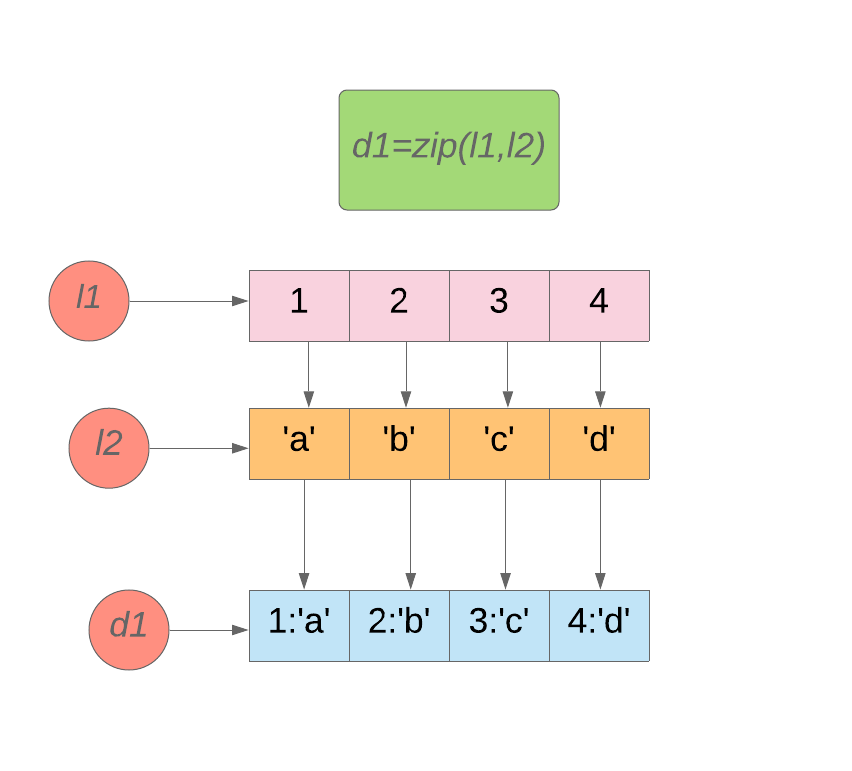Python数据结构 (Python Data Structures)
Python lists and dictionaries are two data structures in Python used to store data. A Python list is an ordered sequence of objects, whereas dictionaries are unordered. The items in the list can be accessed by an index (based on their position) whereas items in the dictionary can be accessed by keys and not by their position.
Python列表和字典是Python中用于存储数据的两个数据结构。 Python列表是对象的有序序列,而字典是无序的。 列表中的项目可以通过索引(基于它们的位置)来访问,而字典中的项目可以通过键而不是它们的位置来访问。
Let's see how to convert a Python list to a dictionary.
让我们看看如何将Python列表转换成字典。
将Python列表转换为字典的十种不同方法 (Ten different ways to convert a Python list to a dictionary)
- Converting a list of tuples to a dictionary 将元组列表转换为字典
- Converting two lists of the same length to a dictionary 将两个相同长度的列表转换为字典
- Converting two lists of different length to a dictionary 将两个不同长度的列表转换为字典
- Converting a list of alternative key, value items to a dictionary 将备用键,值项列表转换为字典
- Converting a list of dictionaries to a single dictionary 将词典列表转换为单个词典
- Converting a list into a dictionary using enumerate() 使用enumerate()将列表转换成字典
- Converting a list into a dictionary using dictionary comprehension 使用字典理解将列表转换为字典
- Converting a list to a dictionary using dict.fromkeys() 使用dict.fromkeys()将列表转换成字典
- Converting a nested list to a dictionary using dictionary comprehension 使用字典理解将嵌套列表转换为字典
- Converting a list to a dictionary using Counter() 使用Counter()将列表转换为字典
1.将元组列表转换为字典 (1. Converting a List of Tuples to a Dictionary)
The dict() constructor builds dictionaries directly from sequences of key-value pairs.
dict()构造函数直接从键值对序列中构建字典。
l1=[(1,'a'),(2,'b'),
(3,'c'),(4,'d')]
d1=dict(l1)
print (d1)
#Output:{1: 'a', 2: 'b', 3: 'c', 4: 'd'}2.将两个相同长度的列表转换成字典 (2. Converting Two Lists of the Same Length to a Dictionary)
We can convert two lists of the same length to the dictionary using zip().
我们可以使用以下命令将两个相同长度的列表转换为字典 zip() 。
zip() will return an iterator of tuples. We can convert that zip object to a dictionary using the dict() constructor.
zip()将返回一个元组的迭代器。 我们可以使用以下方式将zip对象转换为字典 dict()构造函数。
压缩() (zip())
Make an iterator that aggregates elements from each of the iterables.
创建一个迭代器,以聚合每个可迭代对象中的元素。
“
zip(*iterables): Returns an iterator of tuples, where the i-th tuple contains the i-th element from each of the argument sequences or iterables. The iterator stops when the shortest input iterable is exhausted. With a single iterable argument, it returns an iterator of 1-tuples. With no arguments, it returns an empty iterator.” — Python documentation“
zip ( *iterables ):返回一个元组的迭代器,其中第i个元组包含每个参数序列或iterables中的第i个元素。 当最短的可迭代输入耗尽时,迭代器停止。 使用单个可迭代参数,它返回1元组的迭代器。 没有参数,它将返回一个空的迭代器。” — Python 文档
Example:
例:
l1=[1,2,3,4]
l2=['a','b','c','d']
d1=zip(l1,l2)
print (d1)#Output:<zip object at 0x01149528>
#Converting zip object to dict using dict() contructor.
print (dict(d1))
#Output:{1: 'a', 2: 'b', 3: 'c', 4: 'd'}








 本文详细介绍了在Python中将列表转换为字典的十种方法,包括将元组列表、相同长度或不同长度的两个列表、备用键值对列表、字典列表,以及使用enumerate()、字典理解、dict.fromkeys()、Counter()等方法进行转换。
本文详细介绍了在Python中将列表转换为字典的十种方法,包括将元组列表、相同长度或不同长度的两个列表、备用键值对列表、字典列表,以及使用enumerate()、字典理解、dict.fromkeys()、Counter()等方法进行转换。
 最低0.47元/天 解锁文章
最低0.47元/天 解锁文章















 2598
2598

 被折叠的 条评论
为什么被折叠?
被折叠的 条评论
为什么被折叠?








